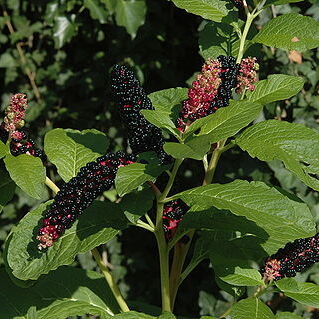Herbs or shrubs, rarely trees, erect, rarely scandent. Root usually thick, fleshy. Stems and branches terete, sulcate or angular, glabrous or young shoot and inflorescence pubescent. Leaves petiolate, rarely sessile; leaf blade ovate, elliptic, or lanceolate, apex acute or obtuse. Flowers pedicellate or sessile, in racemes, cymose panicles, or spikes, terminal or leaf-opposed. Tepals 5, persistent, spreading or reflexed, oblong to ovate, herbaceous or membranous, apex obtuse. Stamens 6-33, inserted at base of tepals; filaments subulate or linear, free or connate at base, included or exserted. Ovary subglobose, carpels 5-16, free or connate. Styles subulate. Fruit a fleshy berry, oblate. Seeds black, shiny, reniform, compressed; testa hard and fragile, smooth; tegument membranous.
Herbs, shrubs or rarely trees. Leaves sessile or petiolate; stipules absent. Inflorescences mostly terminal racemes or spikes, occasionally thyrsiform or paniculiform below; bracts 1-3, at base of pedicel; bracteoles randomly inserted along pedicel. Flowers bisexual, or unisexual and dioecious; sessile or pedicellate; tepals 5, free, equal or subequal; stamens (5-)8-22(-33), in 1 or 2 whorls, on a hypogynous disk; ovary 5-16-carpellate, carpels free or united, ovule 1 per carpel, basal, campylotropous, styles free, spreading or appressed-recurved. Fruits aggregations of 1-seeded drupelets ("berries") or syncarpous 5-16-loculed berries; seed 1 per cell, reniform or subreniform, black, shining, endosperm mealy, embryo curved or annular.
Tall perennial herbs or shrubs. Leaves alternate, simple, entire, petiolate, ex-stipulate, generally glabrous. Inflorescence a terminal, or extra-axillary raceme; the pedicels basally bracteate, often with 1 or more bracteoles above. Tepals 5, equal, usually glabrous, persistent or deciduous in fruit. Stamens 8-22, inserted at the base of the calyx usually on a hypogynous disc, in 1 or 2 cycles, the filaments free, the anthers dorsifixed. Ovary subglobose, 5-to 1 6-carpellate, the carpels completely or only partly united, the styles equal in number to the carpels, terminal, generally connivent, often recurved, the ovule solitary in each cavity. Fruit a globose 5-to 16-celled fleshy berry. Seed 1 in each cavity, the endosperm mealy.
Herbs, shrubs or trees, mostly glabrous; hairs simple when present. Leaves alternate, simple, entire, exstipulate in Australia. Inflorescence a terminal, axillary or lateral raceme, bracteate. Flowers unisexual or bisexual, actinomorphic or zygomorphic. Perianth of 4 or 5 free, uniseriate, petaloid, imbricate tepals, equal or unequal, persistent. Stamens 3 to many, hypogynous, free; anthers 2-locular; stamens reduced to staminodes or absent in ♀ flowers. Ovary superior (rarely inferior outside Australia); carpels 1 to many, free or connate; styles as many as carpels, free; ovules 1 per carpel, basal. Fruit a nut, achene, drupe or berry. Seeds erect, with endosperm enclosed by large embryo.
Herbs or shrubs, occasionally trees, glabrous except for infl. Lvs thin and herbaceous. Fls ☿ or unisexual, small, in terminal or subterminal, often spiciform and erect racemes. Perianth 5-merous, lobed, or with tepals almost free, coloured, often becoming dark red, ultimately reflexed. Stamens (5)-7-22-(33), 1-2-seriate, ± irregularly arranged on disc; anthers dorsifixed. Carpels 5-10-(16), whorled, connate laterally; whole ovary depressed, globose or subglobose. Fr. a berry, or berry-like drupe, longitudinally 5-10-grooved. Seed laterally compressed with asymmetric base.
Herbs [shrubs or trees], perennial. Leaves alternate. Inflorescences axillary, terminal, or leaf-opposed racemes or spikes, 5-100-flowered, proximalmost pedicels sometimes bearing more than 1 flower. Flowers: sepals 5-8; stamens (7-)8-25(-30), sometimes in 1-2 whorls; carpels 6-12(-30), distinct or connate at least proximally; if connate, ovary 6-12-loculed; style and stigma 1 per carpel. Fruits either oblate berries, style persisting in ring at apex, or group of lenticular achenes. Seeds 6-12(-30) per berry or 1 per achene.
Fls perfect or unisexual (the pls then dioecious), racemose, with 5 sep, 5–30 stamens, and a ring of 5–15 separate or ± connate carpels; herbs or woody pls. 35, mostly warm regions.

